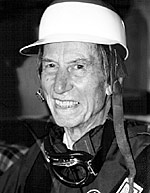
|
Titles by the Author |
John Fitch
John Fitch has led a life that would humble a scriptwriter. He’s been a blue-water sailor, a fighter pilot, a test pilot, a professional racing driver, a team manager, race course director, prolific inventor, highway safety expert, automaker, entrepreneur and dreamer.He was born John Cooper Fitch in Indianapolis, Indiana, August 4, 1917. He is a descendent of the inventor of the steamboat. His step-father was an executive with the old Stutz car company so Fitch witnessed auto racing at an early age, attending the Indianapolis 500 race in the passenger seat of a Stutz Bearcat at the Brickyard.
In the late thirties, Fitch went from Kentucky Military Institute to Lehigh University to study civil engineering. In 1939 he traveled to Europe and saw the last race at Brooklands just days before Chamberlain’s declaration of World War II. Returning to the ’States, he sailed around the Gulf of Mexico in a 32-foot schooner from Sarasota to New Orleans. In the spring of 1941 he volunteered in the Army Air Corps.
In 1944, as a P-51 pilot in the Fourth Fighter Group on bomber escort missions near the end of World War II, he became one of the first Americans to shoot down a German jet fighter. After 4 years of combat duty and just 2 months before the end of the war, he was himself shot down and became a POW. Then seven years after shooting at the Germans, he was driving their racing cars - in the cockpit of a Mercedes-Benz 300SL prototype at the 1952 Pan American Road Race. The previous year he had been the first Sports Car Club of America National Champion.
For 18 years during the 50s and 60s, Fitch had a racing career that included driving for Mercedes-Benz and the Cunningham Team, with major wins in the Grand Prix of Argentina, the Mille Miglia, Tourist Trophy and Sebring. Fitch also drove six times in the Le Mans 24-hour race, finishing as high as 3rd. He was the first racing team manager for Corvette (in 1956 and 1957) and he was the first general manager of the Lime Rock race course.
During the latter part of his racing career he entered the field of highway safety by designing, developing and successfully testing the Fitch Barrier. This is the sand-filled plastic-barrel crash cushion that is commonly seen in front of bridge abutments. Used in 51 states, it is credited with saving thousands of lives. Fitch is the only person in the highway safety field who personally crashed-tested barriers of his own design.
In 1998 John Fitch received the Kenneth Stonex Award from the Transportation Research Board, a part of the National Academy of Sciences, for his lifelong contributions in the field of roadside safety.
![[B] Bentley Publishers](http://assets1.bentleypublishers.com/images/bentley-logos/bp-banner-234x60-bookblue.jpg)